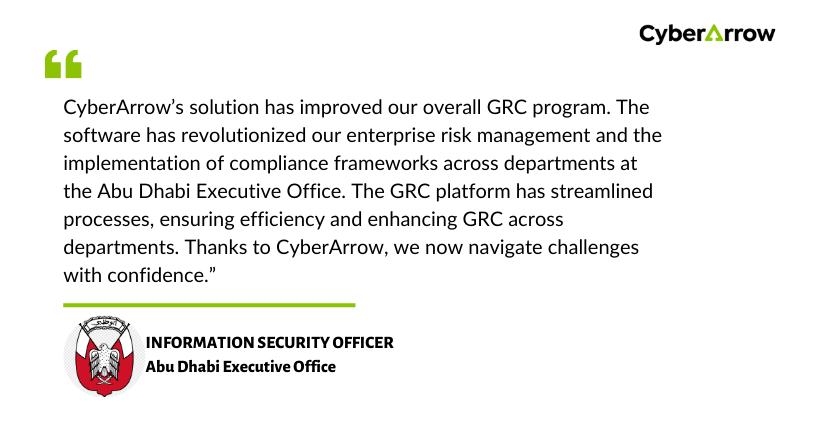Imagine a major data breach shutting down your operations overnight with no backup plan. This can cost your company millions, with the average breach costing $4.45 million, and destroy customer trust. Without a proper enterprise risk management (ERM) strategy, unexpected disruptions can lead to huge financial and reputational damage.
Did you know that companies with a solid ERM strategy are more likely to avoid major financial losses?
Let’s discuss what enterprise risk management (ERM) is, how it can help you manage risks, and how tools like CyberArrow can implement ERM to ensure smooth and secure business operations.
What is enterprise risk management (ERM)?

Enterprise risk management (ERM) is a structured, consistent, and continuous process implemented across an entire organization to enhance its security posture. It involves identifying, assessing, managing, and monitoring risks that could potentially affect the organization's ability to achieve its objectives.
ERM provides a comprehensive framework for risk management that integrates risk considerations into all aspects of the organization’s decision-making processes.
It includes:
Risk identification: Recognizing potential threats and opportunities that could impact the organization.
Risk assessment: Evaluating the likelihood and potential impact of identified risks.
Risk mitigation: Developing strategies to manage and mitigate risks, including risk avoidance, reduction, sharing, and acceptance.
Risk monitoring: Continuously monitoring and reviewing the risk landscape to ensure effective management and timely adjustments.
Why is enterprise risk management (ERM) important?
Enterprise Risk Management (ERM) is essential for modern businesses due to its comprehensive approach to identifying, assessing, and managing organizational risks.
Here’s why your business needs ERM:
Better risk awareness:
A solid ERM program boosts awareness of potential risks across the entire organization. This means everyone, from frontline staff to top executives, is on the same page when it comes to spotting and handling risks.
Confidence in Achieving Goals:
ERM gives businesses confidence in reaching their strategic goals. By tackling enterprise risks head-on, companies can pursue their objectives knowing they have a clear view of potential challenges.
Stronger Compliance:
ERM helps ensure you meet regulatory and internal standards, reducing the risk of legal issues and maintaining your organization’s integrity. It provides a structured way to stay compliant with all necessary requirements.
Increased operational efficiency:
ERM helps standardize processes and controls across your organization. This consistency cuts down on redundancies and streamlines procedures, making operations run more smoothly.
Cultural shift:
Adopting ERM changes the corporate culture from just meeting IT compliance to focusing on overall risk reduction. This shift requires a clear view of your organization’s entire risk and security landscape, encouraging a more comprehensive approach to managing risks.
What are the challenges of enterprise risk management (ERM)?
Implementing enterprise risk management (ERM) can be challenging due to various factors that organizations often encounter. Here are some common challenges:
Complexity and integration: ERM requires integration across different organizational departments and functions. Aligning risk management practices with business goals and operational processes can be complex and requires clear communication and coordination.
Resource constraints: Adequate resources, including financial, technological, and human resources, are essential for effective ERM implementation. Limited budgets or competing priorities may hinder the organization's ability to allocate resources to ERM initiatives.
Data quality and availability: ERM relies on accurate and timely risk assessment and decision-making data. Data quality, consistency, and availability issues can affect the effectiveness of ERM efforts.
Risk assessment and prioritization: Identifying and assessing risks comprehensively can be challenging, especially in dynamic business environments. Prioritizing risks based on their potential impact and likelihood requires robust methodologies and careful analysis.
Complex regulatory environment: Compliance with regulatory requirements adds another layer of complexity to ERM implementation. Keeping up with regulatory changes and ensuring alignment with industry standards can be demanding.
Monitoring and adaptation: ERM is a continuous process that requires ongoing monitoring and adaptation to changing risks and organizational dynamics. Establishing mechanisms for regular risk reviews and updates is essential but can be challenging without dedicated oversight.
ERM implementation best practices
Below are a few best practices to ensure smooth implementation of enterprise risk management in your organizations:

1. Leadership commitment and governance
Establish clear ownership: Assign responsibility for ERM to a senior executive or committee with authority and resources to drive the initiative.
Integrate ERM into governance structures: Ensure ERM is integrated into the organization's governance framework, with regular oversight and reporting to senior management and the board.
2. Risk culture and awareness
Promote a risk-aware culture: Enable a culture where all employees understand their role in risk management and feel empowered to identify and report risks.
Training and communication: Provide ongoing training and communication to educate employees about ERM principles and processes and their importance to the organization.
3. Risk assessment and identification
Comprehensive risk identification: Implement structured processes to identify and categorize risks across all organizational levels and functions.
Risk assessment methodologies: Use robust methods to assess risks based on likelihood and impact, considering both internal and external factors. You can also make a risk register to map risks.
4. Risk mitigation and response
Develop risk mitigation strategies: Develop proactive strategies to mitigate identified risks, including risk avoidance, reduction, sharing, and acceptance.
Action plans: Establish clear action plans with assigned responsibilities, timelines, and monitoring mechanisms for implementing risk mitigation strategies.
5. Monitoring, review, and continuous improvement
Regular monitoring and reporting: Implement mechanisms to monitor and report on the effectiveness of risk management activities and the status of key risks.
Feedback loop: Establish a feedback loop to review and update risk assessments and mitigation plans based on new information, changing circumstances, and lessons learned.
Transform your enterprise risk management with CyberArrow Enterprise GRC
Facing modern business risks without a plan can cause major disruptions and missed opportunities. But with a strong ERM strategy, you can anticipate uncertainties and ensure sustainable growth.
Implementing an ERM framework protects your organization from threats and empowers you to make informed decisions.
Ready to transform your risk management approach?
Take the next step with CyberArrow Enterprise GRC!
Our ERM module provides real-time insights into your organization's risks, threats, and vulnerabilities. With CyberArrow, you can tackle IT and enterprise risks while staying compliant with regulations and standards.
Don't just take our word for it—see what big companies are saying about CyberArrow!

Ready to strengthen your business resilience and navigate risks with confidence?
Schedule a free demo today and transform your risk management strategy with CyberArrow!
































